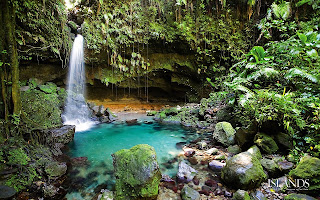Facts on Dominica (Blog post 1)
Dominica, also known as "Commonwealth of Dominica", is a small island in the Caribbean located in the west indies. It is accumulated with Windward Islands in the Caribbean Sea. It has big mountains, hot springs, and tropical rain forest filled with wildlife. Dominica has been nicknamed the "Nature Isle of the Caribbean" due to its beautiful nature. The capital of Dominica is Roseau, which contains a variety of timber houses and botanic gardens. Currently the population of Dominica is 73,925 people. A majority of the people that live here are Roman Catholic. Dominica is one of the few Caribbean islands to be republic.
In Dominica they speak English but their vernacular language is Dominican Creole French. The music they like listening to comes in many styles and genres. Some of the genres are calypso, reggae, soca, kompa, and rock and roll. Dominica also host the World Creole Music Festival. In the earlier years of Dominica, people used carvings and clay to make artwork for the island. Today most of the artwork consist of sculptures and paintings.Mural paintings may be seen just by walking the island and looking aside buildings and walls. The types of foods they make in Dominica actually seem very good. They tend to make sancocho, mangu, and agouti. These are typical dishes a normal family would make if they lived in Dominica.
The island of Dominica is ran by a prime minister. The current prime minister is Roosevelt Skerrit and he has been in charge since 2004. The prime minister is appointed by the president. The current president of Dominica is Charles Sarvarin, who has been president since the year of 2013. The Dominica is one of the few islands in the Caribbean to be republican. The president and prime minister makes up the executive branch.
This is one of the beautiful parts of the tropical rain forest Dominica has to offer.
This is a picture of a hot spring. One of the unique things Dominica is known for.
In Dominica they speak English but their vernacular language is Dominican Creole French. The music they like listening to comes in many styles and genres. Some of the genres are calypso, reggae, soca, kompa, and rock and roll. Dominica also host the World Creole Music Festival. In the earlier years of Dominica, people used carvings and clay to make artwork for the island. Today most of the artwork consist of sculptures and paintings.Mural paintings may be seen just by walking the island and looking aside buildings and walls. The types of foods they make in Dominica actually seem very good. They tend to make sancocho, mangu, and agouti. These are typical dishes a normal family would make if they lived in Dominica.
The island of Dominica is ran by a prime minister. The current prime minister is Roosevelt Skerrit and he has been in charge since 2004. The prime minister is appointed by the president. The current president of Dominica is Charles Sarvarin, who has been president since the year of 2013. The Dominica is one of the few islands in the Caribbean to be republican. The president and prime minister makes up the executive branch.
This is one of the beautiful parts of the tropical rain forest Dominica has to offer.
This is a picture of a hot spring. One of the unique things Dominica is known for.




Comments
Post a Comment